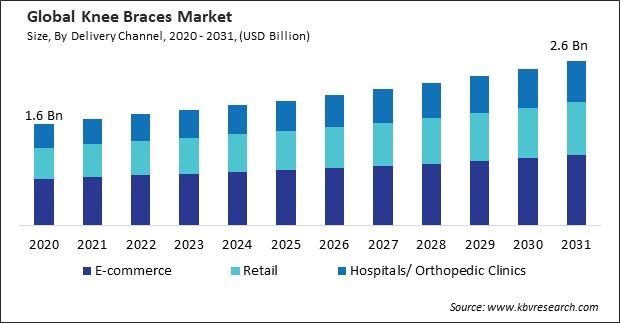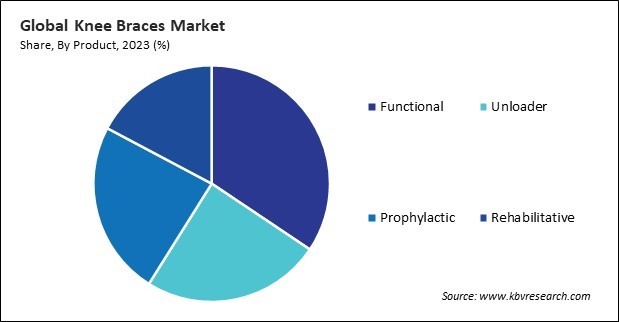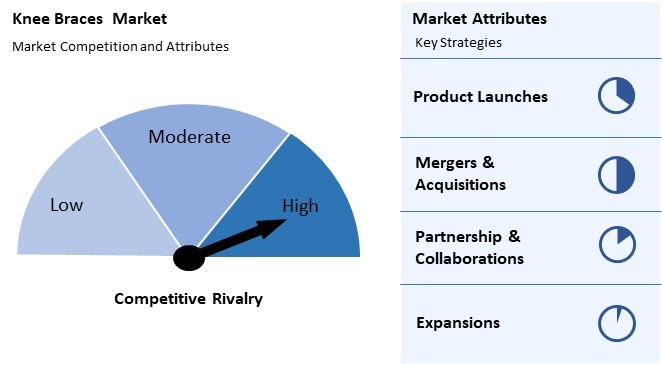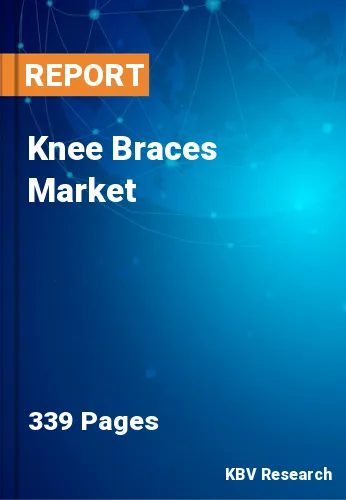“Global Knee Braces Market to reach a market value of USD 2.6 Billion by 2031 growing at a CAGR of 4.6%”
The Global Knee Braces Market size is expected to reach $2.6 billion by 2031, rising at a market growth of 4.6% CAGR during the forecast period. In the year 2023, the market attained a volume of 15,490.2 thousand units, experiencing a growth of 5.7% (2020-2023).
North America has a significant prevalence of knee injuries and conditions such as ligament tears, osteoarthritis, and sports-related injuries. Consequently, the North America region captured $622.9 million revenue in the market in 2023. Also, the Mexico market utilized 375.5 thousand units of braces in 2023. The region’s active lifestyle, participation in sports activities, and aging population contribute to the increased incidence of knee problems, driving the demand for knee braces as a supportive and rehabilitative solution.

With more people engaging in sports and fitness activities, knee injuries such as ligament sprains, meniscus tears, and patellar dislocations are likely to be sustained. The increased incidence of these injuries is driven by the need for these braces as a prophylactic intervention to support the knee joint and lower the risk of damage during physical activities. Professional and amateur athletes use the braces to protect against injuries and provide stability during training and competitions. Thus, growing sports participation and fitness trends propel the market’s growth.
Additionally, rapid urbanization and infrastructure development in many regions have led to increased rates of road traffic accidents and workplace injuries, resulting in a higher incidence of knee injuries. ACL injuries in females between the ages of 5 and 14 had the largest yearly growth rate in injury incidence (10.4%), according to demographic research. Similarly, as per the Government of Canada, the total number of injuries from traffic increased to 108,018 in 2021, up 3.6% from 2020 (104,286) in Canada. In conclusion, rising prevalence of knee injuries globally are propelling the market’s growth.
However, in cases of severe traumatic injuries such as complete ligament tears or fractures, it may have limited efficacy as standalone treatments. Individuals with complex knee instabilities due to multiple ligament injuries or ligament laxity may find limited benefit from standard off-the-shelf braces. Custom-made braces or surgical interventions may be necessary to adequately address the specific instability patterns and restore stability to the knee joint. Hence, the limited efficacy for certain conditions impedes the market’s growth.
The pandemic-induced lockdowns, travel restrictions, and trade disruptions disrupted global supply chains, affecting the production and distribution of these braces and related components. Manufacturers faced challenges in sourcing raw materials, components, and packaging materials, leading to production and delivery timelines delays. During the peak of the pandemic, many healthcare facilities postponed or canceled elective surgeries and procedures to prioritize resources for COVID-19 patients and minimize the risk of virus transmission. Thus, the COVID-19 pandemic moderately impacted the market.
By delivery channel, the market is divided into e-commerce, hospitals/ orthopedic clinics, and retail. In 2023, the E-commerce segment registered the 44.59% revenue share in the market. In terms of volume, E-commerce segment registered 7,498.4 thousand units in 2023. E-commerce platforms offer unparalleled convenience for consumers to browse, compare, and purchase these braces from the comfort of their homes.
On the basis of product, the market is segmented into unloader, functional, prophylactic, and rehabilitative. In 2023, the prophylactic segment attained a 28.35% revenue share in the market. In terms of volume, prophylactic segment consumed 2,386.8 thousand units in 2023. Prophylactic knee braces are specifically designed to prevent knee injuries before they occur.

Based on application, the market is divided into arthritis, sports, ligament, and others. In 2023, the arthritis segment garnered the 38.08% revenue share in the market. In terms of volume, arthritis segment make use of 5,422.8 thousand unit in the market in 2023. Arthritis, especially osteoarthritis, causes joint pain and discomfort, particularly in weight-bearing joints like the knees. Also, the prevalence of arthritis is increasing the demand for knee braces.
Free Valuable Insights: Global Knee Braces Market size to reach USD 2.6 Billion by 2031
Region-wise, the market is analyzed across North America, Europe, Asia Pacific, and LAMEA. In 2023, the Asia Pacific region generated a 29.09% revenue share in the market. In terms of volume, cans segment would register 4,755.0 thousand units in the market in 2023. The Asia Pacific region has witnessed a surge in sports participation and recreational activities across various age groups.

The Market exhibits a competitive landscape driven by factors such as technological advancements, product innovation, strategic collaborations, and the presence of key players. Market competition is characterized by a diverse range of manufacturers offering a variety of the braces catering to different consumer needs, including prophylactic, functional, rehabilitative, and unloader braces. Established companies vie for market share through extensive product portfolios, brand recognition, and distribution networks, while emerging players focus on niche segments or innovative technologies to gain a foothold in the market. Overall, the market competition in the Market is intense, fostering ongoing innovation and product development aimed at addressing the evolving needs of patients and healthcare professionals alike.
| Report Attribute | Details |
|---|---|
| Market size value in 2023 | USD 1.8 Billion |
| Market size forecast in 2031 | USD 2.6 Billion |
| Base Year | 2023 |
| Historical Period | 2020 to 2022 |
| Forecast Period | 2024 to 2031 |
| Revenue Growth Rate | CAGR of 4.6% from 2024 to 2031 |
| Quantitative Data | Volume in Thousand Units, Revenue in USD Billion, and CAGR from 2020 to 2031 |
| Number of Pages | 339 |
| Number of Tables | 730 |
| Report coverage | Market Trends, Revenue Estimation and Forecast, Segmentation Analysis, Regional and Country Breakdown, Porter’s 5 Forces Analysis, Company Profiling, Companies Strategic Developments, SWOT Analysis, Winning Imperatives |
| Segments covered | Product, Delivery Channel, Application, Region |
| Country scope |
|
| Companies Included | Enovis Corporation (DJO Global, Inc.), 3M Company, Ossur Hf. (Embla Medical hf.), Orthofix Medical, Inc. (Breg, Inc.), Mueller Sports Medicine, Inc., McDavid, Inc. (EZ GARD Industries, Inc.), Bauerfeind AG, Medi GmbH & Co. KG, Ottobock SE & Co. KGaA, Tynor Orthotics Private Limited |
By Delivery Channel (Volume, Thousand Units, USD Billion, 2020-2031)
By Product (Volume, Thousand Units, USD Billion, 2020-2031)
By Application (Volume, Thousand Units, USD Billion, 2020-2031)
By Geography (Volume, Thousand Units, USD Billion, 2020-2031)
This Market size is expected to reach $2.6 billion by 2031.
Increasing adoption of non-invasive treatment options are driving the Market in coming years, however, Limited efficacy for certain conditions restraints the growth of the Market.
Enovis Corporation (DJO Global, Inc.), 3M Company, Ossur Hf. (Embla Medical hf.), Orthofix Medical, Inc. (Breg, Inc.), Mueller Sports Medicine, Inc., McDavid, Inc. (EZ GARD Industries, Inc.), Bauerfeind AG, Medi GmbH & Co. KG, Ottobock SE & Co. KGaA, Tynor Orthotics Private Limited
In the year 2023, the market attained a volume of 15,490.2 thousand units, experiencing a growth of 5.7% (2020-2023).
The Functional segment is leading the Market by Product in 2023; there by, achieving a market value of $834.4 million by 2031.
The North America region dominated the Market by Region in 2023, and would continue to be a dominant market till 2031; there by, achieving a market value of $838.5 million by 2031.
Our team of dedicated experts can provide you with attractive expansion opportunities for your business.

 Drivers
Drivers
 Restraints
Restraints
 Opportunities
Opportunities
 Challenges
Challenges
